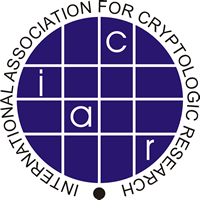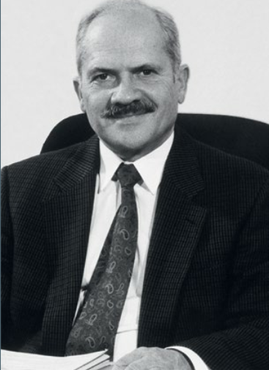
The International Association for Cryptologic Research (IACR) is a non-profit scientific organization that furthers research in cryptology and related fields. The IACR was organized at the initiative of David Chaum at the CRYPTO '82 conference.
The Journal of Cryptology is a scientific journal in the field of cryptology and cryptography. The journal is published quarterly by the International Association for Cryptologic Research. Its editor-in-chief is Vincent Rijmen.

David Kahn was an American historian, journalist, and writer. He wrote extensively on the history of cryptography and military intelligence.
Provable security refers to any type or level of computer security that can be proved. It is used in different ways by different fields.
Aegean Park Press was a publisher based in Walnut Creek, California, specializing in cryptology, military intelligence, contract bridge and Mayan languages. The company's books on cryptology were "mostly reprints of fairly advanced texts, "[i]ncluding at least 16 books by World War II cryptologists William F. Friedman, Lambros D. Callimahos, and Solomon Kullback. It published more than 50 books related to cryptology and a smaller number of books on other areas such as military intelligence." It did most of its business by direct mail.
Shihāb al-Dīn Abū 'l-Abbās Aḥmad ibn ‘Alī ibn Aḥmad ‘Abd Allāh al-Fazārī al-Shāfiʿī better known by the epithet al-Qalqashandī, was a medieval Egyptian encyclopedist, polymath and mathematician. A native of the Nile Delta, he became a Scribe of the Scroll, or clerk of the Mamluk chancery in Cairo, Egypt. His magnum opus is the voluminous administrative encyclopedia Ṣubḥ al-Aʿshá.

Gustavus J. Simmons is a retired cryptographer and former manager of the applied mathematics Department and Senior Fellow at Sandia National Laboratories. He worked primarily with authentication theory, developing cryptographic techniques for solving problems of mutual distrust and in devising protocols whose function could be trusted, even though some of the inputs or participants cannot be. Simmons was born in West Virginia and was named after his grandfather, a prohibition officer who was gunned down three years before Gustavus was born. He began his post-secondary education at Deep Springs College, and received his Ph.D in mathematics from the University of New Mexico, Albuquerque.
Thomas Alan Berson is a cryptographer and computer security researcher. His notable work includes several cryptanalytic attacks, and research in the practical use of cryptographic protocols, particularly in computer networks.

Cryptography, or cryptology, is the practice and study of techniques for secure communication in the presence of adversarial behavior. More generally, cryptography is about constructing and analyzing protocols that prevent third parties or the public from reading private messages. Modern cryptography exists at the intersection of the disciplines of mathematics, computer science, information security, electrical engineering, digital signal processing, physics, and others. Core concepts related to information security are also central to cryptography. Practical applications of cryptography include electronic commerce, chip-based payment cards, digital currencies, computer passwords, and military communications.
PRIMUS: Problems, Resources, and Issues in Mathematics Undergraduate Studies is a peer-reviewed academic journal covering the teaching of undergraduate mathematics, established in 1991. The journal has been published by Taylor & Francis since March 2007. It is abstracted and indexed in Cambridge Scientific Abstracts, MathEduc, PsycINFO, and Zentralblatt MATH.
The following is a timeline of probability and statistics.
Alan Theodore Sherman is a full professor of computer science at UMBC, director of the UMBC Center for Information Security and Assurance (CISA), and director of the UMBC Chess Program. Sherman is an editor for Cryptologia, and is a member of Phi Beta Kappa and Sigma Xi.
ʻAfīf al-Dīn ʻAlī ibn ʻAdlān al-Mawsilī, born in Mosul, was an Arab cryptologist, linguist and poet who is known for his early contributions to cryptanalysis, to which he dedicated at least two books. He was also involved in literature and poetry, and taught on the Arabic language at the Al-Salihiyya Mosque of Cairo.
Jonathan Katz is a professor in the Department of Computer Science at the University of Maryland who conducts research on cryptography and cybersecurity. In 2019–2020 he was a faculty member in the Volgenau School of Engineering at George Mason University, where he held the title of Eminent Scholar in Cybersecurity. In 2013–2019 he was director of the Maryland Cybersecurity Center at the University of Maryland.
Batch cryptography is the area of cryptology where cryptographic protocols are studied and developed for doing cryptographic processes like encryption/decryption, key exchange, authentication, etc. in a batch way instead of one by one. The concept of batch cryptography was introduced by Amos Fiat in 1989.
Chaotic cryptology is the application of mathematical chaos theory to the practice of cryptography, the study or techniques used to privately and securely transmit information with the presence of a third-party or adversary. Since first being investigated by Robert Matthews in 1989, the use of chaos in cryptography has attracted much interest. However, long-standing concerns about its security and implementation speed continue to limit its implementation.

Wilhelm Fenner was a German cryptanalyst, before and during the time of World War II in the OKW/Chi, the Cipher Department of the High Command of the Wehrmacht, working within the main cryptanalysis group, and entrusted with deciphering enemy message traffic (Cryptography). Wilhelm Fenner was considered an excellent organizer, an anti-Nazi, an anti-Bolshevik and a confirmed Protestant and was known by colleagues as someone who was keen to continue working in cryptology after World War II. To quote military historian David Alvarez:

Karl Ludwig Föppl was a German mechanical engineer who succeeded his father, August Föppl as Professor of Technical Mechanics at the Technical University of Munich. During World War I, Föppl worked as a cryptanalyst, initially in Inspectorate 7/VI, and later in the war within General der Nachrichtenaufklärung.

Otto Leiberich was a German cryptologist and mathematician. Leiberich is most notable for establishing the Bundesamt für Sicherheit in der Informationstechnik in 1991.
Hans Karl Georg Heinrich Pietsch was a German mathematician who was most notable for being a director of the Mathematical Referat of the Wehrmacht signals intelligence agency, the General der Nachrichtenaufklärung during World War II.






